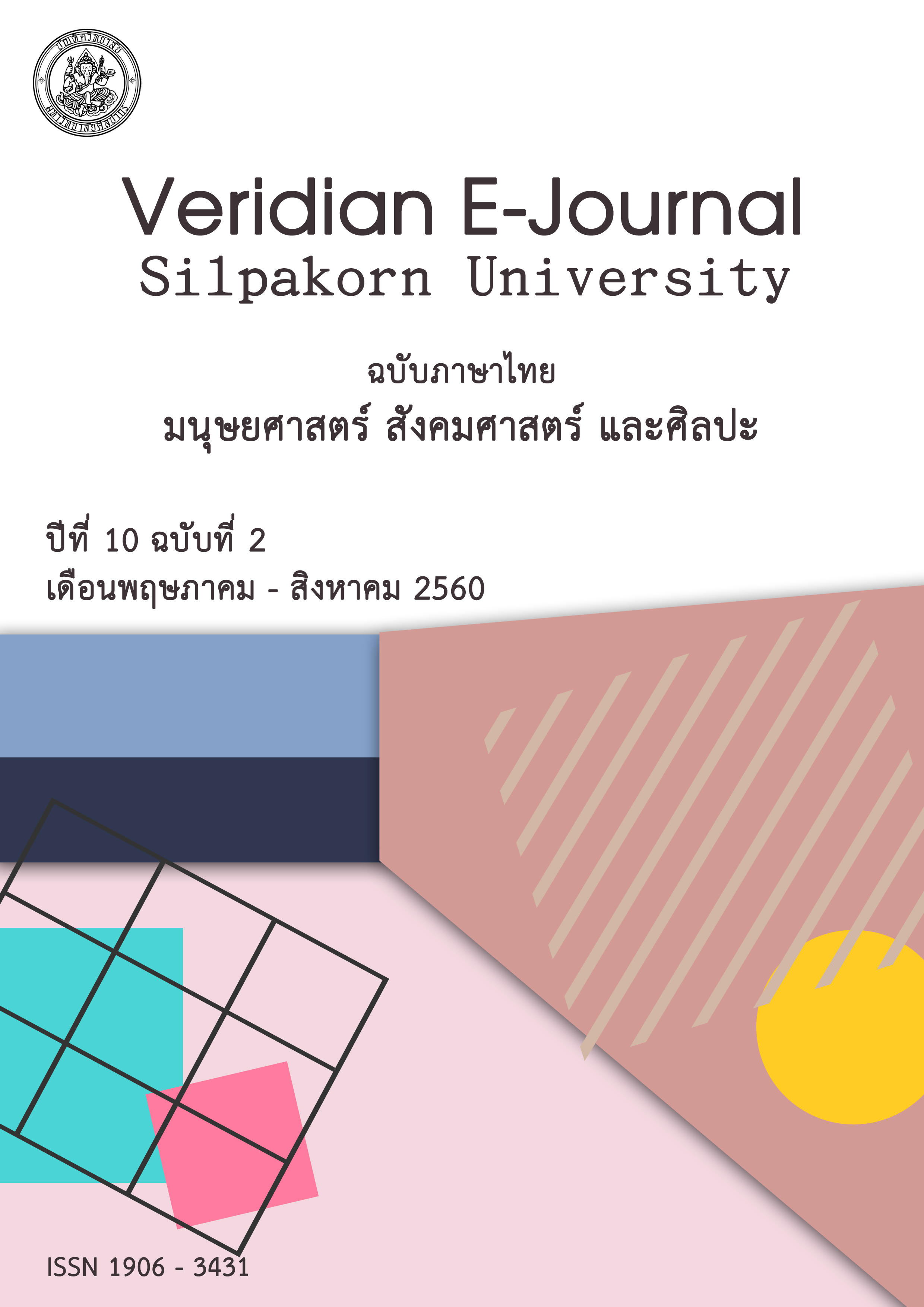การวิจัยเชิงปฏิบัติการแบบมีส่วนร่วมในการจัดกิจกรรมการท่องเที่ยวโดยชุมชนตามหลักปรัชญาของเศรษฐกิจพอเพียงเพื่อเสริมสร้างเศรษฐกิจชุมชน จังหวัดนครราชสีมา
Main Article Content
Abstract
การวิจัยครั้งนี้ใช้ระเบียบวิธีวิจัยเชิงปฏิบัติการแบบมีส่วนร่วม (Participatory Action Research: PAR) มีวัตถุประสงค์เพื่อ ศึกษาสภาพการจัดกิจกรรมการท่องเที่ยวโดยชุมชนของจังหวัดนครราชสีมา และ ศึกษาแนวทางการจัดกิจกรรมการท่องเที่ยวโดยชุมชนตามหลักปรัชญาของเศรษฐกิจพอเพียงเพื่อเสริมสร้างเศรษฐกิจชุมชน จังหวัดนครราชสีมา พื้นที่ในการศึกษาคือ ชุมชนตำบลไทยสามัคคี อำเภอวังน้ำเขียว จังหวัดนครราชสีมา กลุ่มตัวอย่างที่ใช้ในการศึกษาคือ ประชาชนที่อาศัยอยู่ในตำบลไทยสามัคคีจำนวน 364 คน ผู้ให้ข้อมูลหลักคือผู้มีส่วนเกี่ยวข้องกับการจัดกิจกรรมการท่องเที่ยวโดยชุมชน ได้แก่ ผู้ว่าราชการจังหวัด เกษตรจังหวัด การท่องเที่ยวและกีฬาจังหวัด พัฒนาการจังหวัด หัวหน้าส่วนราชการนักวิชาการ ผู้นำชุมชน ผู้นำศาสนา ปราชญ์ชาวบ้าน รวมทั้งสิ้น 24 คน เก็บข้อมูลโดยการสอบถาม ลงสำรวจพื้นที่ศึกษา สัมภาษณ์เชิงลึก ประชุมกลุ่มย่อย และสนทนากลุ่ม เก็บรวบรวมข้อมูลระหว่างเดือน มกราคม 2559 – เมษายน 2560 การวิเคราะห์ข้อมูลใช้การหาค่าความถี่ ค่าร้อยละ ค่าเฉลี่ย ส่วนเบี่ยงเบนมาตรฐาน และการวิเคราะห์เนื้อหา
ผลการวิจัยพบว่า 1) สภาพการจัดกิจกรรมการท่องเที่ยวโดยชุมชนของจังหวัดนคราชสีมา มีแนวโน้มในการท่องเที่ยวที่ดี เพราะสภาพพื้นที่เหมาะกับการจัดกิจกรรมการท่องเที่ยวที่หลากหลาย มีแหล่งเรียนรู้ ศูนย์การเรียนรู้ ปราชญ์ชาวบ้าน ผู้นำชุมชนที่รับผิดชอบทางด้านการจัดกิจกรรมการท่องเที่ยวและประชาชนในพื้นที่มีการน้อมนำหลักปรัชญาเศรษฐกิจพอเพียงมาใช้ในการดำเนินชีวิต และได้รับการสนับสนุนทั้งจากหน่วยงานภาครัฐ ภาคเอกชน และชุมชน ตามนโยบายประชารัฐรักสามัคคี 2) แนวทางการจัดกิจกรรมการท่องเที่ยวโดยชุมชนตามหลักปรัชญาของเศรษฐกิจพอเพียงเพื่อเสริมสร้างเศรษฐกิจชุมชน จังหวัดนครราชสีมาทำให้ได้รูปแบบที่พัฒนาขึ้น คือรูปแบบ พายน์ทรีซีโฟร์เอส โมเดล “PIE3C4S Model” ซึ่งประกอบด้วย 10 องค์ประกอบได้แก่ P : (Participation of Community) หมายถึงการมีส่วนร่วมของชุมชน I : (Income) หมายถึงรายได้ E : (Environment) หมายถึง สิ่งแวดล้อม C1 : (Conservation) หมายถึงการอนุรักษ์ C2 : (Community Strength) หมายถึงชุมชนเข้มแข็ง C3 : (Creation) หมายถึงการสร้างสรรค์ S1 : (Self–Sufficiency) หมายถึงความพอเพียง S2 : (Sustainability) หมายถึงความยั่งยืน S3 : (Suitability) หมายถึงความเหมาะสม S4 : (Safety) หมายถึงความปลอดภัย ผลจากการประเมินรูปแบบที่พัฒนาขึ้นโดยผู้ทรงคุณวุฒิระดับความเหมาะสมในระดับมาก ผลจากการนำรูปแบบ“PIE3C4S Model” ไปใช้ในพื้นที่สามารถนำไปใช้ได้อย่างเหมาะสมในชุมชนไทยสามัคคี กิจกรรมเหมาะสมกับบริบทของชุมชน การจัดกิจกรรมการท่องเที่ยวโดยชุมชนต้องอยู่บนพื้นฐานของความปลอดภัย โดยมีแนวทางในการพัฒนาการจัดกิจกรรมการท่องเที่ยวโดยชุมชนที่สำคัญได้แก่ การส่งเสริมให้หน่วยงานเข้ามามีส่วนร่วมในการจัดกิจกรรมการท่องเที่ยวมากขึ้น ส่งเสริมให้ชุมชนมีรายได้เพิ่มขึ้น ส่งเสริมการจัดตั้งกลุ่มพัฒนาอาชีพ อนุรักษ์ทรัพยากรสิ่งแวดล้อม และให้คนในชุมชนดำเนินชีวิตตามหลักปรัชญาเศรษฐกิจพอเพียง
This research, conducted with a participatory action research (PAR) approach, aimed to study the management of tourism activities of the community at Nakhon Ratchasima province, and examine guidelines for the management of tourism activities according to the philosophy of sufficiency economy to strengthen the community economy at Thai Samakkhi sub-district, Wang Nam Khiao district, Nakhon Ratchasima province. The subjects of the study were 364 residents of Thai Samakkhi sub-district. Key informants were the residents of Thai Samakkhi sub-district and 24 related people, who participated in the management of tourism activities by the community, such as the provincial governor, agriculturist, tourism and sports officials, developers, chiefs of divisions, academics, community leaders, religious leaders, and local scholars. The data were collected on field study, questionnaire, in-depth interview, small group meetings, focus group discussion, during January 2016 – May 2017. Then the data were analyzed for frequency, percent, mean, standard deviation, and content analysis.
The results were 1) the management of tourism activities by the community in Nakhon Ratchasima province was likely to be favorable since the area was suitable for various tourism activities, had learning resources, learning centers, local scholars, community leaders responsible for the management of tourism activities, and people in the area adopted the philosophy of sufficiency economy to use in their way of life, supported by both public and private sectors as well as the people, based on the policy of civil unity. 2) The guideline for the management of tourism activities based on the philosophy of sufficiency economy to strengthen the community economy in Nakhon Ratchasima province was “PIE3C4S Model” created with 10 elements; P: Participation of Community, I : Income, E : Environment, C1 : Conservation, C2 : Community Strength, C3 : Creation, S1 : Self–Sufficiency, S2 : Sustainability, S3 : Suitability, and S4 : Safety. The results of the Model evaluation by the experts were highly appropriate, and the implementation of the “PIE3C4S Model” in the Thai Samakkhi community was appropriate with the context of the community. The management of tourism activities had to base on safety, and the main guideline for the management of tourism activities were encouragement work organizations to participate more in the management, the community had more income, encouragement for establishing career developmental group, conservation of environmental resource, and supported residents to live with the philosophy of sufficiency economy.
